Diplomatic Bluebook 2015
Chapter 3
Japan’s Foreign Policy to Promote National and Worldwide Interests
2.Cultural Diplomacy
(1) Overview
Respect for mutual understanding is essential for people-to-people and cultural exchanges. Therefore, endeavoring to deepen foreign countries’ understanding towards Japan is important through introducing Japanese traditional culture, cuisine and pop culture such as animation, manga and fashion, while at the same time Japan is making efforts to understand overseas views and cultures.
MOFA performs a wide range of activities to foster pro-Japanese groups in the next generation and promote understanding towards Japan.
Examples of these activities include providing information on studies in Japan and building alumni networks through Japan’s diplomatic missions overseas, collaborating with the JET Programme which invites young people from abroad to local areas, undertaking exchange programmes for young people from Asia and the US as well as for adults, sending visiting professors to universities and research institutions overseas, and offering subsidies for research activities.
Promoting Japanese language education overseas fosters future leaders who will build a bridge between Japan and overseas, deepens understanding towards Japan, and lays a foundation for friendship with other countries. MOFA engages in dispatching Japanese language specialists overseas, providing training for Japanese language teachers from overseas in Japan, and developing Japanese language teaching materials, through the Japan Foundation.
It is also important to enhance the presence of Japan in the area of sports for the successful delivery of the 2020 Olympic and Paralympic Games in Tokyo. As part of the “Sport for Tomorrow” programme, MOFA implements various sport exchange/sport promotion projects in many countries, the dispatch of sport instructors by JICA volunteers or through the Japan Foundation, and the provision of sports goods and equipment.
Using the budget allocated to strategic communications, MOFA intends to enhance support for researchers of Japan studies, expand personal exchange and sports exchange programs and further promote Japanese language education.
In cooperation with the United Nations Education, Scientific and Cultural Organization (UNESCO), earnest efforts are being made to preserve the world’s tangible and intangible cultural heritage (see (7) for details). For Japan, “Tomioka Silk Mill and Related Sites” was inscribed on the World Heritage List and “Washi, craftsmanship of traditional Japanese hand-made paper” was inscribed on the Representative List of the Intangible Cultural Heritage of Humanity.
(2) Cultural Exchange Programmes
It helps maintain and improve Japan’s presence in the international community to boost understanding towards Japan among foreign nationals who form the foundation of public opinion and policy making as well as to make Japan’s image even more positive. MOFA engages in promoting diverse attractiveness of Japan through diplomatic missions overseas and the Japan Foundation.
Following the launch of the new cultural exchange initiative “WA Project: Toward Interactive Asia through Fusion and Harmony” in December 2013, the Japan Foundation established the Asia Center in April 2014. The Center sets 1) support for Japanese language studies including through the dispatch of 3,000 NIHONGO (Japanese language) Partners and 2) interactive arts and cultural exchange projects as its two main pillars. The Center sent the first batch of NIHONGO Partners to Indonesia, Thailand and the Philippines in September 2014.
As the first “WA” project in the area of arts and cultural exchange, an exhibition entitled, “Beauty of KŌGEI: Art Crafts in Japan” was held at the Japan Creative Center (JCC) of the Japanese Embassy in Singapore from May to June 2014. The exhibition introduced selected art crafts (ceramics, textile, bamboo work and urushi lacquer work) from 14 KŌGEI artists, including three living national treasures. The opening ceremony was attended by Prime Minister Abe and Mr. Sam Tan Chin Siong, Minister of State of Singapore for Prime Minister’s office and Ministry of Culture, Community and Youth for a ceremonial ribbon cutting. Besides this, the Japan Foundation operates various projects such as an exchange program in cooperation with the Tokyo International Film Festival, and a football exchange program in cooperation with the Japan Football Association.
In view of deepening interests in each culture and mutual understanding, MOFA is actively involved in international cultural exchanges through pop culture such as Japan’s world famous animation, manga and fashion, in addition to traditional culture, arts and cuisine.
The International Manga Award was launched in 2007 as part of these activities by MOFA with the aim of honoring manga artists who have contributed to the promotion of manga culture overseas. The 8th International Manga Award of 2014 received 317 entries from 46 countries, and the Gold Award went to the work of a Mongolian applicant, making the first winner from Mongolia with two other winners from the Middle East. This indicates the world-wide spread every year and the increasing level of quality of manga production inspired by Japanese manga.
MOFA conducts large-scale and comprehensive programmes in commemorative years celebrating diplomatic events in cooperation with governmental and private organisations through mutual visits of high-level officials, various conferences and public relations/cultural projects, aiming for even more effective promotion of the understanding forwards Japan. In 2014, among others various events took place as a project commemorating the 150th anniversary of the Establishment of Diplomatic Relations between Switzerland and Japan, which included a Japanese calligraphy exhibition, a
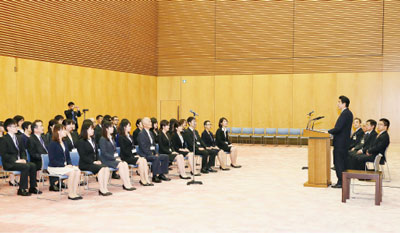 The first group of the NIHONGO Partners visiting Prime Minister Abe (September 22, Prime Minister of Japan and His Cabinet; Source: Cabinet Public Relations Office)
The first group of the NIHONGO Partners visiting Prime Minister Abe (September 22, Prime Minister of Japan and His Cabinet; Source: Cabinet Public Relations Office)
 Prime Minister Abe cutting a ribbon at the opening ceremony of the “Beauty of KŌGEI: Art Crafts in Japan” (May 31, Singapore; Source: Cabinet Public Relations Office)
Prime Minister Abe cutting a ribbon at the opening ceremony of the “Beauty of KŌGEI: Art Crafts in Japan” (May 31, Singapore; Source: Cabinet Public Relations Office)
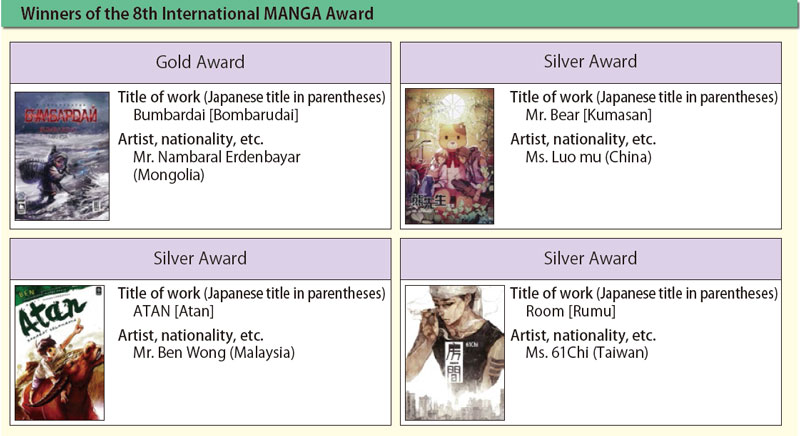
 Beyond Kimono—Beauty of Japan (July 8, museum in the outskirts of Berlin)
Beyond Kimono—Beauty of Japan (July 8, museum in the outskirts of Berlin)
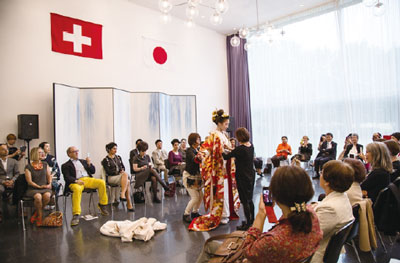 Beyond Kimono—Beauty of Japan (July 9. Japanese Embassy in Switzerland)
Beyond Kimono—Beauty of Japan (July 9. Japanese Embassy in Switzerland)
(3) People-to-People Exchange and Exchange in the Area of Education
MOFA carries out a number of invitational projects to build personal relations and promote the understanding of Japan by inviting foreign nationals who have a great influence on shaping public opinion and policy decisions in other countries and those who are expected to play a leading role in the future. Also in the area of education and sports, MOFA is in charge of various activities to promote exchanges between a wide range of people. These projects not only promote mutual understanding and friendly relationships, but also increase Japan’s presence in the international community and as a rather significant consequence bring diplomatic benefits adding to the national interest of Japan.
A. Exchange with foreign students
MOFA actively introduces the attractiveness of studying in Japan to foreign students and provides them with opportunities to study in Japan through diplomatic missions overseas. MOFA also implements application and selection procedures to accept competent students from around the world as Japanese Government (MEXT) Scholarship students. Furthermore, it is making efforts to maintain relations with former foreign students who have returned to their home countries through Japan Alumni Associations and to foster pro-Japanese individuals and groups.

B. JET Programme (Japan Exchange and Teaching Programme)
The JET Programme was launched in 1987. The Programme received about 1,700 new participants in FY2014, with the total number of overall participants reaching over 60,000. The Ministry of Internal Affairs and Communications, the Ministry of Foreign Affairs, the Ministry of Education, Culture, Sports, Science and Technology and the Council of Local Authorities for International Relations take part in the management of the programme, in which local governments invite young foreign nationals to Japan and appoint them to a post in the local government (project implementing body is the local government) with the aim of improving foreign language education and promoting international exchange. MOFA is responsible for the application and selection process at diplomatic missions overseas, pre-departure orientation and support for the activities of the JET Programme Alumni Association (JETAA). Many former JET participants are successful in various fields as pro-Japanese in different parts of the world and they are valuable human/diplomatic assets for Japan. The JETAA (membership numbers about 24,000 people), established in 15 countries, contributes to the promotion of understanding of Japan in each country.
 The 4th Kenya-Japan Alumni Association Annual General Meeting (August, Japan Information & Culture Centre of the Embassy of Japan in Kenya)
The 4th Kenya-Japan Alumni Association Annual General Meeting (August, Japan Information & Culture Centre of the Embassy of Japan in Kenya)
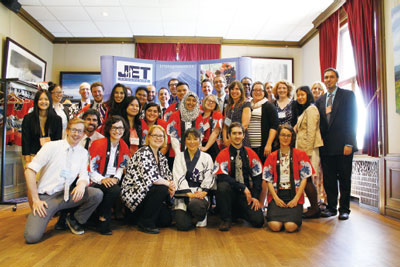 JET participants before coming to Japan (June, Consulate General of Japan in Montreal)
JET participants before coming to Japan (June, Consulate General of Japan in Montreal)

C. Sport exchange
Sport enables communications beyond language and can be an effective tool for promoting friendly relations and the understanding of Japan. As a host country of the 2020 Olympic and Paralympic Games in Tokyo, Japan is attracting much interest from foreign countries The Government of Japan commenced “Sport for Tomorrow” programme as an international cooperation initiative through sport in January 2014. This programme implements various sport exchanges/sport promotion projects in different countries, with the aim of spreading the value of sport by 2020, targeting over 10 million people in more than 100 countries. Particularly, since the year 2014 marks the 50th anniversary of the 1964 Tokyo Olympic Games, there were a number of commemorating events by sport organizations in various countries, and MOFA was actively involved in these events through diplomatic missions overseas.
(4) Exchange in the Intellectual Realm
A. Japanese studies
MOFA supports a range of overseas research activities related to Japan’s politics, economy, society and culture. In FY2014, MOFA provided various forms of support through the Japan Foundation. Specifically, MOFA sent visiting scholars, enhanced the collection of books on Japan and provided research grants to 64 institutions of Japanese studies in 28 countries and regions, such as universities and research institutions with the potential of becoming Japanese studies hubs. Also, fellowship status was granted to 205 researchers on Japan from 42 countries/regions, including those who have been continuing from the previous year, so that they can conduct research and study activities in Japan (as of December 2014 for both). In addition to these, MOFA helps academic societies to promote network building among researchers and research institutions on Japan in different countries and regions.
B. Intellectual Exchanges
MOFA implements intellectual exchange projects, putting emphasis on cooperative work/exchange with other countries. Specifically, MOFA plans and supports exchange programs among academics to strengthen relationships and deepen mutual understanding through seminars, symposia and conventions on common international agenda via the Japan Foundation. While cooperating with NPOs and exchange associations in Japan, MOFA implemented projects to develop leaders of the next-generation who will lead intellectual exchanges and provided support for grass-root activities for international exchanges.
C. US-Japan Conference on Cultural and Educational Interchange (CULCON)1
As for strengthening educational and cultural exchanges between Japan and the United States, it is mentioned in the annex of the US-Japan joint statement released in April 2014, that both Japanese and US governments share the goal, established by CULCON in June 2013, of doubling two-way student exchanges by the year 2020. In November 2014, the 26th CULCON was convened in Washington, D.C. and both countries confirmed plans to track and analyze progress towards achieving CULCON’s goal.
- 1 In accordance with the Joint Declaration between Prime Minister Hayato Ikeda and President John F. Kennedy of the United States in 1961, the US-Japan joint conference has been held biannually since 1962, with the aim of broadening cooperation between the two countries in the area of culture and education.
D. Cooperation with the United Nations University (UNU)
The Government of Japan invited the United Nations University (UNU), which contributes to the international community through study and research on global issues and human resources development, to base its headquarters in Japan and, as host country, has provided various cooperation and support for 40 years. The UNU, in collaboration with Japanese universities and research institutions, is engaged in international issues on which Japan focuses and is an important organization for appealing the policies of the Government of Japan. The UNU established Master’s and Doctoral Programmes in 2010 and 2012, respectively, in an attempt to improve its global human resources development programmes.

(5) Promotion of Japanese Language Education
The Japanese language has been gaining increasing interests from overseas as Japanese economy gets more globalized to promote more Japanese companies to operate overseas and Japanese pop culture gets accepted worldwide.
Further promotion of the Japanese language around the world leads to creating a favorable international environment for the Japanese people and companies. About 3.99 million people in 136 countries and regions of the world are learning the Japanese language (Survey on Japanese-Language Education Abroad 2012, Japan Foundation). The number of learners has been steadily increasing since the first survey in 1979 by more than 30 times. In 2014, approximately 680,000 examinees (the number of applicants, including tests conducted in Japan) took the Japanese-Language Proficiency Test of the Japan Foundation in 258 cities of 67 countries and regions worldwide.
Based on the recommendations of the “Final Report” submitted in December 2013 by the Expert’s Meeting for Promotion of the Japanese Language Overseas established under Foreign Minister Kishida, MOFA responds to various needs in Japanese-language educational sites through the Japan Foundation: specifically through dispatching of Japanese language specialists, providing training in Japan for Japanese teachers overseas and foreign diplomats, developing teaching materials and disseminating the JF (Japan Foundation) Japanese Language Education Standard2. Moreover, the Japan Foundation aims to further increase the number of Japanese language learners overseas through further utilization of audio-visual teaching materials, such as learning aid websites with animation and manga, and through directly managed Japanese courses.
The Japan Foundation has also been making efforts for the creation and expansion of the JF Nihongo Network (aka; Sakura Network), mainly at the JF overseas centers and universities where dispatched Japanese language specialists have been working since FY2007 in order to develop promotional programs for Japanese language based on various needs of each country/region and to enhance partnerships between relevant organizations. In 2014, the number of organizations/associations designated as core members of the Sakura Network reached a total of 127 centers in 47 countries/regions and will be further expanded in the future.
- 2 A concept concerning methods of teaching and learning the Japanese language and methods of evaluating learning outcomes developed and presented by the Japan Foundation using the Common European Framework of Reference for Language (CEFR) as a reference. Expressed in six levels, Japanese language proficiency is evaluated in each level with a focus on what can be done using the Japanese language. It can be used for course design, development of teaching materials and test preparation.
(6) Cultural Grant Aid
The government of Japan provides Cultural Grant Assistance, a part of Official Development Assistance (ODA) to promote culture and higher education in developing countries thereby enhancing mutual understanding and friendly relations between Japan and developing countries. The activities implemented in 2014 include five General Cultural Grant Assistance projects (total of 970 million yen) and 20 Grassroots Cultural Grant Assistance projects (total of 150 million yen). In 2014, the emphasis of cultural grants was placed on the dissemination of broadcast contents and sports, aiming at enhancing the value of the ‘Japan Brand’.
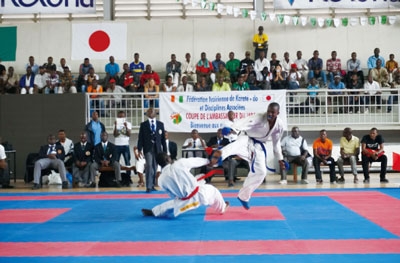 Cote d’Ivoire Karate Ambassador of Japan Cup using developed equipment (September 13, Karate Training at the Félix Houphouët-Boignyin in Abidjan)
Cote d’Ivoire Karate Ambassador of Japan Cup using developed equipment (September 13, Karate Training at the Félix Houphouët-Boignyin in Abidjan)
(7) Cooperation through United Nations Educational, Scientific and Cultural Organization (UNESCO)
A. Overview
Japan plays an active role in various projects of UNESCO in the areas of education, science and culture. UNESCO is the first international organization of which postwar Japan became a member state in 1951. The importance of the role of education, science and culture in development assistance has been increasingly recognized and Japan will continue emphasizing cooperative relations with UNESCO.
In the area of culture, Japan offers active cooperation identifying the safeguarding of world’s tangible/intangible cultural heritage and assistance in the area of human resources development as the pillars. At the same time, Japan actively participates in the international framework for cultural heritage conservation. As part of such activities, Japan established two Japanese Funds-in-Trust at UNESCO, aiming for the safeguarding of tangible and intangible cultural heritage. The Japanese Funds-in-Trust for the Preservation of the World Cultural Heritage carries out conservation and restoration of remains led by Japanese experts, such as the Angkor monument in Cambodia and Tombs of Buganda Kings at Kasubi in Uganda. It also contributes to the development of human resources so that local people can protect the remains by themselves in the future.
The Japanese Funds-in-Trust for the Safeguarding of the Intangible Cultural Heritage supports projects intended to hand down traditional performing arts, such as music and dance, and traditional crafts in developing countries to the next generation and develops domestic institutions in preparation for the conclusion of the Convention for the Safeguarding of the Intangible Cultural Heritage.
In the area of education, Japan set up the Japanese Funds-in-Trust for the Capacity-building of Human Resources to develop human resources in developing countries. In this scheme, Japan provides support for human resources development mainly in the area of education, including promotion of Education for All (EFA) led by UNESCO. As a support for “Education for Sustainable Development” (ESD), Japan co-hosted with UNESCO the “UNESCO World Conference on Education for Sustainable Development (ESD)” in Okayama and Nagoya in November 2014. The conference was held to mark the final year of the UN Decade of Education for Sustainable Development (DESD 2005–2014) and adopted the “Aichi-Nagoya Declaration” calling upon concerned parties to take specific actions to further strengthen ESD.
In terms of other collaboration with UNESCO, Japan contributed a total amount of 1 million US dollars in March 2014 to the “Humanitarian Aid in Disaster/Conflict-Affected Countries Sub-Saharan Africa” which UNESCO implements in Mali and the Republic of the Congo. Japan also contributed 500,000 US dollars to the “Emergency Psychosocial Support for Secondary School-aged Students Affected by Typhoon Yolanda in the Philippines.”
B. World Heritage Convention
The World Heritage Convention aims to protect cultural and natural heritage, which is regarded as the heritage of all mankind. Japan became a party to the Convention in 1992 (current number of parties to the Convention is 191). The ones listed on the World Heritage List are so-called “World Heritage” sites. There are three types of sites: cultural (buildings and remains), natural (natural areas) and mixed (having elements of both cultural and natural). As of December 2014, a total of 1,007 World Heritage sites are listed on the World Heritage List. At the 38th World Heritage Committee meeting in Qatar in 2014, it was decided that the Tomioka Silk Mill and Related Sites would be inscribed on its list, raising the number of the World Heritage sites in Japan to 18: 14 cultural sites and 4 natural sites. Japan has served as a member of the World Heritage Committee from 2011 to 2015.
C. Convention for the Safeguarding of the Intangible Cultural Heritage
The Convention for the Safeguarding of the Intangible Cultural Heritage aims to develop an international system for safeguarding intangible cultural heritage, such as traditional performing arts and traditional craftsmanship techniques (current number of parties to the convention is 161). Japan, having rich experience in safeguarding intangible cultural properties, has provided active contributions playing the role of engine for developing the Convention by formulating the major sections of the implementation guidelines. A total of 314 properties of the world including 22 properties of Japan are listed on the “Representative List of the Intangible Cultural Heritage of Humanity” developed in accordance with the Convention. It includes “Nôgaku theatre”, “Ningyo Johruri Bunraku puppet-theatre” and “Kabuki theatre”, which have been proclaimed by UNESCO as “Masterpieces of the Oral and Intangible Heritage of Humanity.” At the 9th Session of the Intergovernmental Committee for the Safeguarding of the Intangible Cultural Heritage in Paris in November 2014, the Committee approved the inscription of “Washi, craftsmanship of traditional Japanese hand-made paper” on UNESCO’s Representative List of the Intangible Cultural Heritage of Humanity, which had been nominated by Japan, and in doing so expanded “Sekishu-Banshi” which was already inscribed on the List in 2009 to include “Hon-minoshi” and “Hosokawa-shi.”
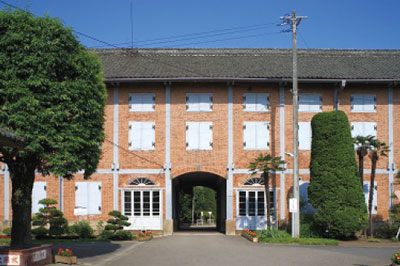 The Tomioka Silk Mill and Related Sites (Source: Gunma Prefecture: Tomikoa Silk Mill East Cocoon Warehouse)
The Tomioka Silk Mill and Related Sites (Source: Gunma Prefecture: Tomikoa Silk Mill East Cocoon Warehouse)
 Washi, craftsmanship of Japanese hand-made paper (Source: Sekishu Washi Kaikan)
Washi, craftsmanship of Japanese hand-made paper (Source: Sekishu Washi Kaikan)
“Abe Cup” Judo Tournament in Côte d’Ivoire

On 11 January 2014, a judo tournament was held in the West African country of Côte d’Ivoire, far from Japan. This was the largest judo tournament in Côte d’Ivoire. As the tournament coincided with Prime Minister Abe’s visit to the country, it was designated by the Government of Japan as the first project under the “Sport for Tomorrow” programme, which aims to contribute to the global community through sports. Organized as a cultural project by the Japanese embassy, this memorable occasion received the unprecedented involvement of the governments of both countries, the judo community, local citizens, as well as the press.
Friendly relations between Japan and Côte d’Ivoire brought about by Judo
 Prime Minister Abe handing judo uniforms to a judo athlete in Côte d’Ivoire
Prime Minister Abe handing judo uniforms to a judo athlete in Côte d’Ivoire
 Mr. Jean Noel PENNAVAYRE undergoing coach training in Abidjan (Source: Solidarity of International Judo Education)
Mr. Jean Noel PENNAVAYRE undergoing coach training in Abidjan (Source: Solidarity of International Judo Education)
Judo, which originated in Japan, is a popular sport around the world today, and Côte d’Ivoire is no exception. With the outbreak of civil war, the people of Côte d’Ivoire were forced to stop holding judo tournaments for more than 20 years. However, tournaments resumed in 2009, and in 2014, with the cooperation of the Japanese embassy and the judo community of the two countries, the Abe Cup was inaugurated using tatami mats supplied by the Government of Japan. The winning men’s team in the finals held on the same day received the championship trophy from Prime Minister Abe in person, generating much excitement among the audience present at the venue. At the same time, it left a strong impression of Japan’s contributions in the cultural and sports areas. After the tournament, Prime Minister Duncan expressed his appreciation for Japan’s continued cooperation.
At the same tournament, both governments and private sectors cooperated and harnessed the power of sports to provide a boost for the national reconciliation efforts that the Côte d’Ivoire government has positioned as a priority issue. This was demonstrated by the donation of 100 sets of judo uniforms from an NPO, Solidarity of International Judo Education (Representative: Yasuhiro Yamashita).
After the tournament, judo coaches from various countries including Côte d’Ivoire were invited to Japan to partake in a training course for coaches. One of the participating coaches was Mr. Jean Noel PENNAVAYRE from Côte d’Ivoire, who had also learnt judo from a Japanese coach in his youth. He spoke about his aspirations, saying, “I aim to make use of the knowledge and experience I have gained through the high-level training I received in Japan to teach judo to my juniors.”
International contributions in the sports area for the Tokyo 2020 Olympic and Paralympic Games
Other than Côte d’Ivoire, the Government of Japan is implementing international contribution projects in the sports sector in more than 100 countries, targeted at more than 10 million people by 2020. The Ministry of Foreign Affairs is also engaged in initiatives to promote the Olympic movement and spread the value of sports to all generations, including the youth who are responsible for the future. These initiatives include developing sports facilities and equipment, and providing support through the dispatch and invitation of instructors and coaches. The Government of Japan is keeping up efforts to ensure that the Tokyo 2020 Games, which will take place in five years, will be a wonderful event that enriches the lives of athletes, spectators and all other people who are involved.
Exchange Programs Division

